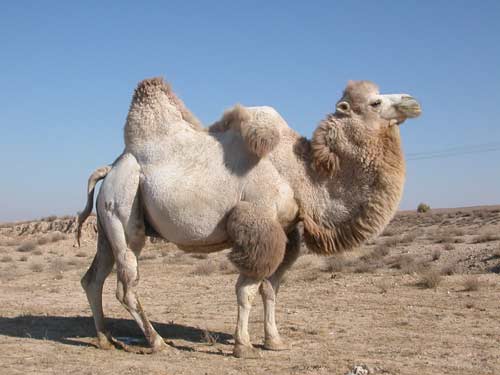|
| Query: arabian camel | Result: 4th of 11 | |
Bactrian Camel (Camelus bactrianus) - Wiki
| Subject: | Bactrian Camel (Camelus bactrianus) - Wiki
| |

| Resolution: 500x375
File Size: 23987 Bytes
Upload Date: 2006:12:25 12:28:05
|
Bactrian Camel
From Wikipedia, the free encyclopedia
[Photo] A Bactrian Camel in the Kyzyl Kum desert in Uzbekistan. Kyzyl Kum (Qyzylqum) is the eleventh largest desert in the world. In the picture: Bactrian camel (Camelus bactrianus). (author Dmitriy Pitirimov, http://pagetour.narod.ru/uzb/Qyzylqum_1.htm)
The Bactrian Camel (Camelus bactrianus) is a large even-toed ungulate native to the steppes of eastern Asia. The Bactrian camel has two humps on its back, in contrast to the Dromedary, also known as the Arabian Camel, which has one.
Nearly all of the estimated 1.4 million Bactrian Camels alive today are domesticated, but in October 2002 the estimated 950 remaining in the wild in northwest China and Mongolia were placed on the critically endangered species list.
Physical characteristics and habitat
Bactrian Camels are over 2 meters (7 feet) tall at the hump and weigh in excess of 725 kg (1,600 lb). They are herbivores, eating grass, leaves, and grains, capable of drinking up to 120 litres (32 US gallons) of water at a time. Their mouths are extremely tough, allowing them to eat thorny desert plants.
They are supremely adapted to protect themselves against the desert heat and sand, with wide, padded feet and thick leathery pads on the knees and chest, nostrils that can open and close, ears lined with protective hairs, and bushy eyebrows with two rows of long eyelashes. Thick fur and underwool keep the animal warm during cold desert nights and also insulate against daytime heat.
The Dromedary (Camelus dromedarius) is the only other surviving camel, native to the Sahara desert, but today is extinct in the wild. By comparison, the Bactrian Camel is a stockier, hardier animal able to survive the scorching desert heat of northern Iran to the frozen winters in Tibet. The Dromedary is taller and faster, and with a rider it can maintain 8???9 mph for hours at a time. A loaded Bactrian Camel moves at about 2.5 mph.
History
It is thought that the Bactrian Camel was domesticated (independently from the Dromedary) sometime before 2500 BCE, probably in northern Iran and Northern Pakistan or southwestern Turkestan. The Dromedary is believed to have been domesticated around 4000 BCE in Arabia. The wild population of Bactrian Camels was first described by Nikolai Przhevalsky in the late 19th century.
Subspecies
There is some evidence that the Bactrian Camel can be divided up into different subspecies. In particular, it has been discovered that a population of wild Bactrian Camel lives within a part of the Gashun Gobi region of the Gobi Desert. This population is distinct from domesticated herds both in genetic makeup and in behavior. However, the significance of those differences has not yet been demonstrated.
There are possibly as many as three regions in the genetic makeup that are distinctly different from domesticated camels and there is up to a 3% difference in the base genetic code. However, with so few wild camels, it is unclear what the natural genetic diversity within a population would have been.
Another remarkable difference is the ability of these wild camels to drink saltwater slush, although it is not yet certain the camel can extract useful water from it. Domesticated camels do not attempt to drink salt water, though the reason is unknown.
http://en.wikipedia.org/wiki/Bactrian_camel
| The text in this page is based on the copyrighted Wikipedia article shown in above URL. It is used under the GNU Free Documentation License. You may redistribute it, verbatim or modified, providing that you comply with the terms of the GFDL. |
|
Comments |
|---|
| | Guest |
|
| The Camelus bactrianus, or Bactrian camel, is a large, even-toed ungulate native to the steppes of Central Asia. It's known for its two humps, which are made up of fat and provide energy and water reserves. Bactrian camels are primarily herbivores, adapting to harsh desert environments with thick fur coats and other unique adaptations. |
^o^
Animal Pictures Archive for smart phones
^o^
|
|
|